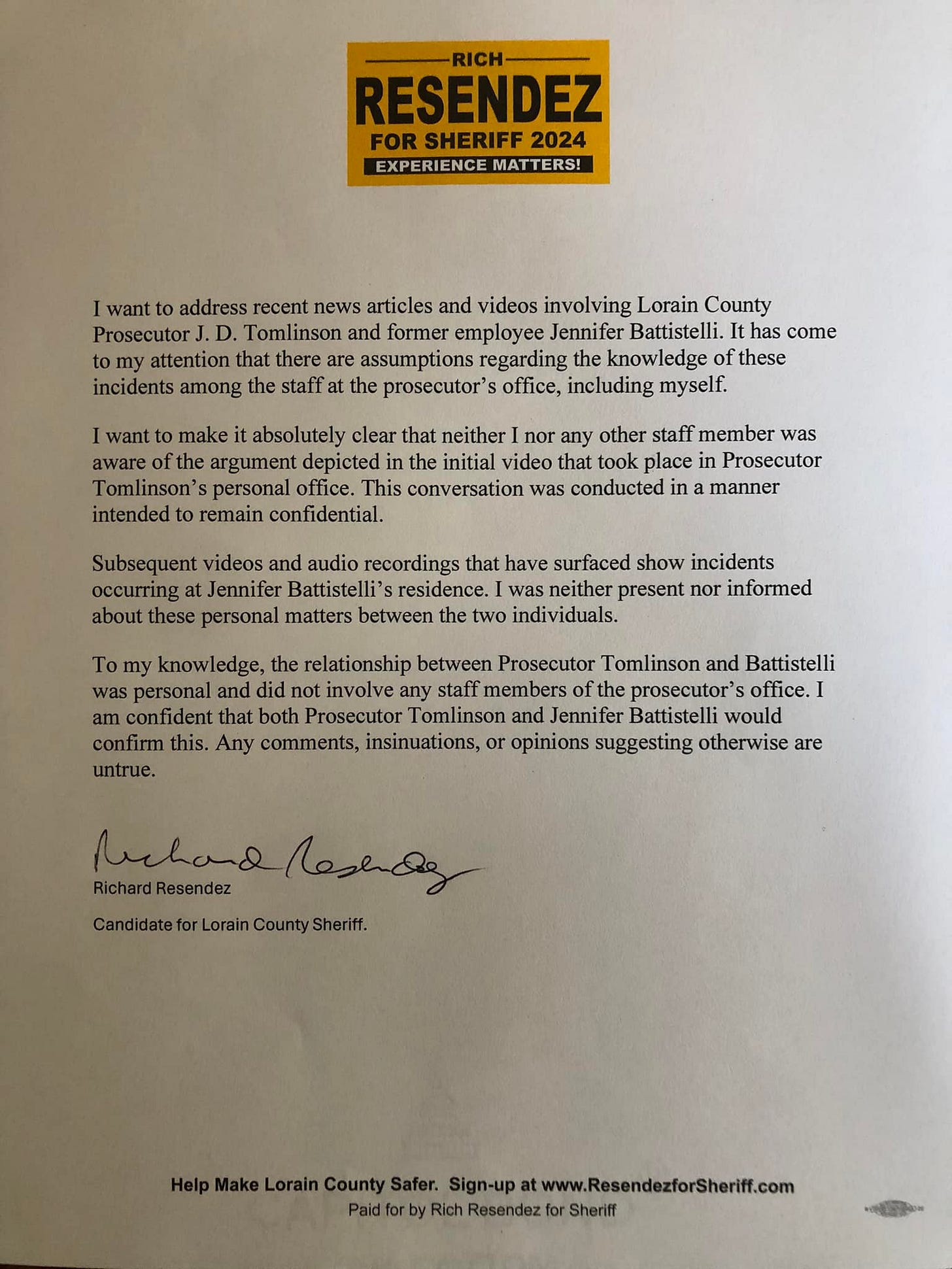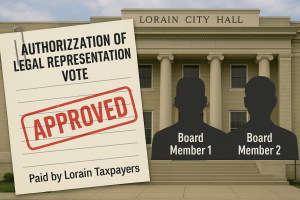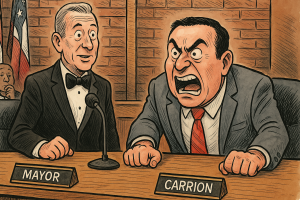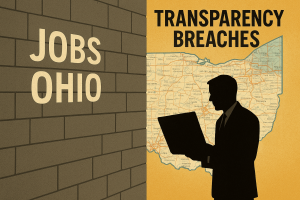The Gatekeeper’s Gamble: Richard Resendez and the Public Denial That Didn’t Hold

He signed the complaint. He read the report. He handed it to Burge. Then he told the public he knew nothing. How one denial unraveled Richard Resendez’s credibility—and nearly cost a 100k truth.
May 26, 2025
By Aaron Knapp
Investigative Reporter, Lorain Politics Unplugged

I. The Letter That Changed Everything
I’ve investigated a lot of public officials over the years. Some deny. Some deflect. But very few put their denial in writing, on campaign letterhead, while the proof sits one drawer away.
Thanks for reading Aaron’s Substack! Subscribe for free to receive new posts and support my work.
That’s exactly what Richard Resendez did.
In the fall of 2024—on the eve of his run for Lorain County Sheriff—Resendez issued a public statement denying any knowledge of the internal conflict between Prosecutor JD Tomlinson and Public Outreach Coordinator Jennifer Battistelli. He claimed, verbatim, that “neither I nor any other staff member was aware of the argument depicted in the initial video.”
At first glance, it read like standard campaign damage control. But I knew something was off. Because by then, I had already seen the paper trail.
The signature at the bottom of Garrett Longacre’s HR complaint against Battistelli? That was Resendez’s. The notation forwarding the complaint to James Burge for investigation? Also Resendez. The internal document acknowledging receipt and departmental review? Again—Resendez.
He didn’t just know. He documented it.
This wasn’t a situation of plausible deniability. It was documented participation. The moment Resendez signed his name on August 8 and again on August 11, 2023, he ceased to be an uninformed bystander. He became the gatekeeper. The one who allowed the complaint to move forward. The one who chose to involve Burge.
And yet, with a straight face, he told the public he didn’t know.
That’s not just misleading. That’s political deception in writing.

II. The Signature and the Silence: Resendez’s Paper Trail of Involvement
The truth about Richard Resendez’s involvement in the Battistelli fallout isn’t buried in hearsay—it’s right there in black and white. Two signatures. One investigation summary. And an internal email trail that shows he was more than a bystander. He was a conduit.
Let’s start with the complaint itself.
On July 27, 2023, Garrett Longacre filed an internal complaint alleging that Jennifer Battistelli had made a false accusation of discrimination against him to Chief Assistant Prosecutor Dan Petticord. According to Longacre, the claim involved a third-party employee—one who, it turns out, never lodged a formal grievance themselves. That distinction matters. Because what followed wasn’t an investigation into discrimination—it was an investigation into Battistelli.
On August 8, the complaint reached Richard Resendez, who signed off on it in his capacity as Department Head. His role was administrative but critical: he accepted the complaint, reviewed it for formal policy violations, and—here’s the part he can’t walk back—passed it directly to Chief of Staff James Burge for disciplinary review.
Three days later, on August 11, Resendez signed the document again, this time confirming that the complaint had been routed for follow-up action. And it was. Within days, Burge issued a formal warning to Battistelli, citing the incident with Longacre as improper conduct and cautioning her against further violations.
This was not a case of office gossip. This was a formal complaint processed through the Prosecutor’s Office internal chain of command. The fact that Resendez touched it twice—and never raised any flags—makes his later denial stunning. He didn’t just read about it. He helped advance it.
Even more damning is the fact that Resendez’s name appears in the internal investigative notes. According to the files later disclosed in deposition, both Longacre and Petticord spoke directly with Resendez about the matter before Burge ever got involved. And once Burge did, Resendez was copied on key updates.
All of this undermines the public statement he made months later during his campaign. And worse, it raises a more troubling question: why deny something that’s so easily proven? Either Resendez believed the public would never see the internal records—or he gambled that no one would care.
If so, he was wrong on both counts.

III. The Facebook Fallout and the Coon Confrontation
The public might never have known about Resendez’s contradiction—if not for a Facebook comment and a political firestorm that followed. When I pointed out the discrepancy between his denial and the documents I had reviewed, it lit a fuse in local political circles. The comment wasn’t buried in an obscure thread; it was posted directly in a heated discussion surrounding the prosecutor’s scandal—and it hit a nerve.
Enter Deb Coon.
Coon, a vocal political ally of Resendez, erupted in response. She accused me of slander, misinformation, and political manipulation. But she never addressed the substance: the fact that Resendez had, in writing, both processed and confirmed the complaint he later denied knowing anything about. Her outrage was loud—but her facts were missing.
What followed was even more revealing. Private messages began to circulate. Screenshots were shared. I received confirmation from multiple sources within the Prosecutor’s Office that Resendez had not only handled the Longacre complaint but discussed it internally with both Petticord and Burge before it escalated into a formal discipline case.
And then, the real twist: one of those internal sources forwarded me a scanned copy of Resendez’s original signature. The date matched. The document matched. And the denial? It was now undeniable.
Still, Resendez never corrected the record. He never clarified his statement. He never explained how his name appeared on formal complaint paperwork if, as he claimed, he “had no knowledge” of what happened.
Instead, he did what too many officials do when caught: he said nothing. He hoped the scandal would move on. He gambled that no one would care.
But the people paying attention did care. And they remembered. Because while others were busy shouting down criticism, the evidence sat in plain view.
IV. The Cost of a Signature—And the $100,000 It Helped Conceal
What made Richard Resendez’s denial so dangerous wasn’t just the lie—it was what the lie tried to cover up. Because that complaint he signed off on? It didn’t just lead to an HR reprimand. It helped justify a $100,000 taxpayer-funded payout, kept hidden from public view for nearly a year.
Let’s break that down: Resendez processed a complaint against Battistelli. That complaint was used by Burge to issue a disciplinary warning. That warning later became part of the county’s justification for quietly settling Battistelli’s EEOC complaint—without court involvement, without public board approval, and without any of it going through CORSA.
In sworn testimony, Burge confirmed that Resendez and Longacre met with him to discuss the allegation. That conversation, he said, prompted his decision to investigate Battistelli and ultimately caution her. The complaint became a cornerstone of the administration’s case that she was the problem—not the workplace culture or the prosecutor who promoted and dated her.
And then came the final act of misdirection: when Resendez ran for sheriff, he distanced himself entirely from the Battistelli fallout. He didn’t just minimize it—he denied it altogether. But it was his signature, his forwarding memo, and his departmental authority that placed the first brick in the road to a six-figure settlement.
After I posted the documentation online, public outrage surged. Even longtime Resendez supporters began to question how he could claim ignorance while leaving a paper trail behind. The silence became deafening.
That’s when Lorain County Sheriff Jack Hall stepped in.
Hall, in a rare move, issued a statement decrying Deb Coon’s behavior—without endorsing anyone or defending the underlying reporting. His letter focused on Coon’s conduct, calling it inappropriate and unbecoming of someone claiming to advocate for the public. While he didn’t mention Resendez by name, the message was broadly seen as an effort to lower the political temperature, not to take sides in the scandal itself.
Resendez responded days later—not with an explanation, but with escalation. In a bold, accusatory post, he lashed out at both Aaron Knapp (myself) and community advocate Garon Petty. He accused us of grandstanding, dishonesty, and trying to “exploit public distrust for personal gain.”
It was a desperate pivot—one that ignored the evidence and attacked the messengers. But by then, the narrative had already slipped from his control.
In one particularly pointed post, Resendez wrote:
“You’re quick to criticize Ms. Coon, but I continually get slandered by Aaron Knapp, Jeff Gavin (Real name Robert Kunsman), Garron Petty and several others.”
What makes this post troubling is not just its tone—it’s the complete absence of evidence. At no point did Resendez cite specific examples of slanderous statements. Instead, he publicly accused private citizens—by name—of defamation without backing those claims with facts. This wasn’t a heated policy dispute between candidates. It was a public official targeting individual voters for speaking up. While the legal standard for defamation is high, especially for those in public discourse, the ethical breach is clear: Resendez used his platform to make unsubstantiated attacks on civilians. In a functioning democracy, that’s not just inappropriate. It’s chilling.
V. A Candidate Without Correction: Why Resendez Never Fixed the Record
There’s a moment in every scandal when the official has a chance to set the record straight. Not walk it back, not gaslight the public—but actually clarify, explain, and own the truth. Richard Resendez had that moment. And he let it pass.
After the documents surfaced. After I posted screenshots of his signed HR paperwork. After colleagues confirmed his involvement in the internal investigation. After Sheriff Hall denounced the toxicity of the political discourse. After Resendez himself attacked his critics by name on Facebook.
“Recently my opponent has threatened me and my campaign with civil action for what he alleges are false statements put out by my campaign .
Let me address each and every allegation . His main complaint seems to stem around Deb Coon.
Whatever his problem or better said her problem with him started when she was YOUR CAMPAIGN MANAGER. Deb Coon could certainly address any questions or concerns about her previous experience with you better than I could.
Per Jack, Deb is a self proclaimed campaign manager. Well Jack she has never been my campaign manager. She is a passionate Lorain County Citizen with her own opinions. So I can’t fire her from a position she has never had.
Your allegations of false information further stems from her and other citizens public records requests about your work history.
I have NEVER asked for any public records on you, as I run on my experience.
It is truly a shame this race has turned into this current situation. I tried to reach out to you several months ago through your supporter Attorney Anthony Nici but Attorney Nici told me you were not interested in meeting with me and setting some professional standards for this race.
Your quick to criticize Ms Coon, but I continually get slandered by Aaron Knapp, Jeff Gavin ( Real name Robert Kunsman), Garron Petty and several others by childish cartoons and memes.
I again ask publicly to meet you and set a professional standard for these last 11 days.
Rich Resendez”
Still—no correction.
What makes this worse is that Resendez didn’t just deny involvement in a social media post—he formalized that denial in a public campaign statement. He wrote, unequivocally, that “neither I nor any other staff member was aware of the argument depicted in the initial video.” But in sworn testimony and documented internal records, his name appears repeatedly: receiving the complaint, forwarding it, meeting with Burge, and signing off on follow-up action. The contradiction isn’t subtle—it’s stark.
He could’ve admitted that his memory was off. He could’ve clarified that he misunderstood the question. He could’ve said, plainly, that he was involved in the complaint’s review but not in later stages. Instead, he said nothing. And hoped no one would connect the dots between what he told voters and what he told investigators.
That silence in the aftermath wasn’t accidental—it was strategic. He counted on voter fatigue. On information overload. On the hope that people would stop caring before they connected the dots. He didn’t need to refute the evidence if he could just outlast it.
It’s a tactic used by officials who know they’ve been caught, but believe the rules don’t apply to them. Don’t admit, don’t explain—just distract. And in Resendez’s case, that distraction came in the form of online attacks, deflection, and vague statements that said a lot about his critics but nothing about the underlying facts.
What he never realized is that the silence itself became the loudest admission.
Because when a public official is confronted with proof of their contradiction—and chooses not to address it—it doesn’t just damage their credibility. It reveals their character.
Resendez didn’t just deny the truth. He tried to bury it. But the documents wouldn’t stay buried. And neither will the public memory of what they exposed.
There’s a moment in every scandal when the official has a chance to set the record straight. Not walk it back, not gaslight the public—but actually clarify, explain, and own the truth. Richard Resendez had that moment. And he let it pass.
After the documents surfaced. After I posted screenshots of his signed HR paperwork. After colleagues confirmed his involvement in the internal investigation. After Sheriff Hall denounced the toxicity of the political discourse. After Resendez himself attacked his critics by name on Facebook.
VI. Silent Hires and Lingering Questions
Since the election, Resendez has gone quiet. He has not issued any follow-up statements, corrections, or public clarifications. But behind the scenes, his career didn’t end. It simply shifted.
According to multiple sources and employment records, Resendez quietly accepted a position with the Lorain Police Department after the election—without fanfare, public notice, or a press release. It was the kind of appointment that slides under the radar unless someone’s watching.
This move raises a serious question: does a candidate who publicly accused private citizens of slander—without evidence—belong in a role of public trust, especially in law enforcement?
This wasn’t a political counterpoint—it was a direct, unproven accusation against private residents who had spoken out. As a sheriff candidate, his words could be dismissed as campaign heat. But as a public employee, those same words begin to resemble a pattern of retaliation and reputational targeting.
Could these statements be considered unlawful? That’s a high legal bar. Defamation law, particularly in Ohio, requires clear evidence that the speaker knowingly made false claims with malicious intent. But unethical? Without question. A public servant using their campaign to intimidate critics is more than a bad look—it’s a threat to civic engagement.
And yet, just like his denial letter, there’s been no correction. No acknowledgment. No accountability.
The gatekeeper now wears a badge. But the gate he guarded—the one between truth and spin—remains open, and unguarded.
Final Thought:
Richard Resendez’s story is not just about a paper trail—it’s about what happens when those entrusted to protect the public trust instead protect themselves. He denied what was documented. He attacked those who exposed it. And he walked away with a government job, while the public is left wondering how many others in power can do the same. If this is what accountability looks like in Lorain County, the real scandal isn’t what Resendez did—it’s how easily the system let him do it.





